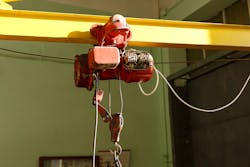The Disconnecting Means for Cranes and Monorail Hoists
Follow these rules to make sure your installation is compliant with the National Electrical Code (NEC).
You must provide a disconnecting means in the leads from the runway contact conductors (or other power supply) of cranes and monorail hoists [Sec. 610.32]. It must be lockable in the open position per Sec. 110.25, and comply with Sec. 430.109.
You can omit the disconnect where a monorail hoist or hand-propelled crane bridge installation meets all of the following:
- It’s controlled from the ground or floor level.
- It’s within view of the power supply disconnecting means.
- There’s no fixed work platform for unit servicing.
And at the operating station, there must be a means for opening the power circuit to all motors of the crane or monorail hoist.
The runway conductors must also have a disconnect complying with Sec. 430.109 [Sec. 610.31]. Additional requirements for this disconnect include:
- Readily accessible operable from the ground/floor.
- Lockable in open position.
- Opens all ungrounded conductors simultaneously.
- In sight from the runway contact conductors, unless that location is impractical or more hazardous, or where written safety procedures in an industrial setting ensure only qualified personnel service the equipment.
About the Author

Mark Lamendola
Mark is an expert in maintenance management, having racked up an impressive track record during his time working in the field. He also has extensive knowledge of, and practical expertise with, the National Electrical Code (NEC). Through his consulting business, he provides articles and training materials on electrical topics, specializing in making difficult subjects easy to understand and focusing on the practical aspects of electrical work.
Prior to starting his own business, Mark served as the Technical Editor on EC&M for six years, worked three years in nuclear maintenance, six years as a contract project engineer/project manager, three years as a systems engineer, and three years in plant maintenance management.
Mark earned an AAS degree from Rock Valley College, a BSEET from Columbia Pacific University, and an MBA from Lake Erie College. He’s also completed several related certifications over the years and even was formerly licensed as a Master Electrician. He is a Senior Member of the IEEE and past Chairman of the Kansas City Chapters of both the IEEE and the IEEE Computer Society. Mark also served as the program director for, a board member of, and webmaster of, the Midwest Chapter of the 7x24 Exchange. He has also held memberships with the following organizations: NETA, NFPA, International Association of Webmasters, and Institute of Certified Professional Managers.
